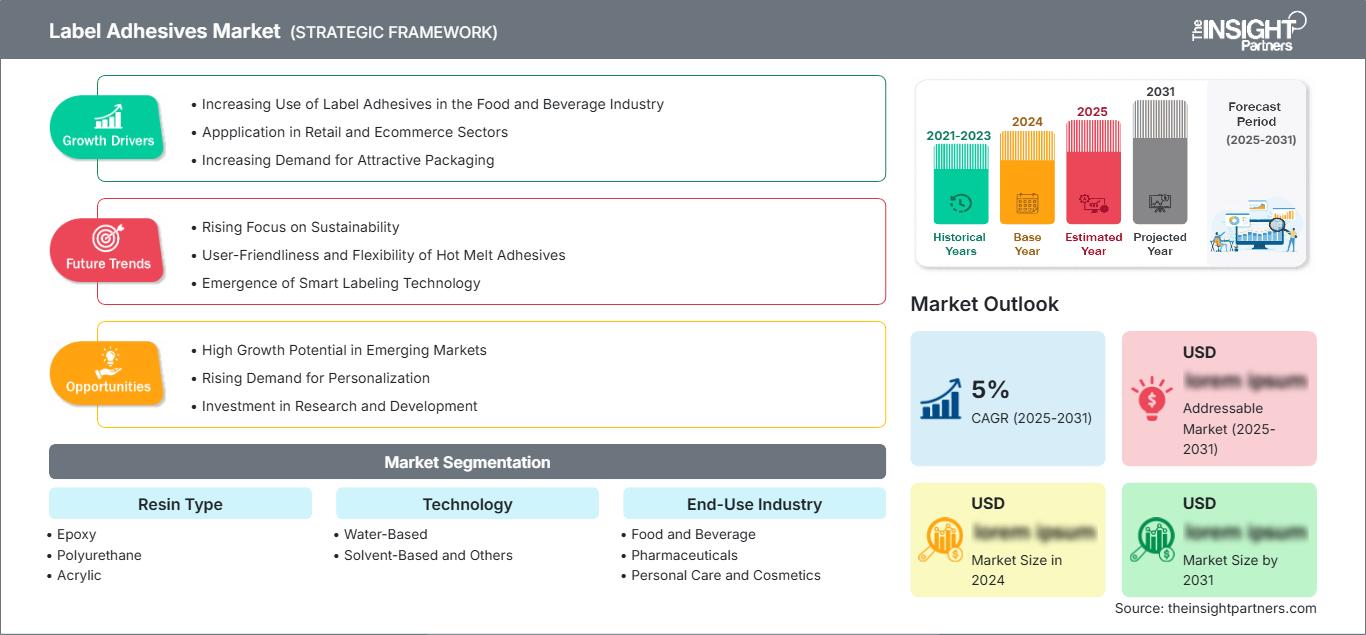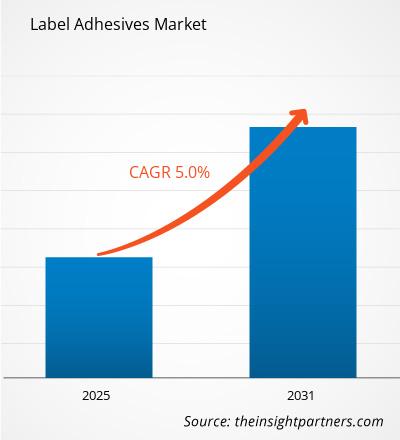预计标签粘合剂市场在 2025 年至 2031 年期间的复合年增长率为 5%,市场规模将从 2024 年的 XX 百万美元扩大到 2031 年的 XX 百万美元。
本报告按树脂类型(环氧树脂、聚氨酯、丙烯酸、聚酰胺等)和技术(水基、溶剂型等)进行细分。该报告进一步根据最终用途行业(食品和饮料、药品、个人护理和化妆品、消费品、家庭护理产品等)进行了分析。全球分析进一步细分为区域和主要国家。该范围涵盖所有关键细分市场的全球、区域和国家层面的市场规模和预测。该报告以美元提供了上述分析和细分的价值。该报告提供了主要市场参与者的市场状况关键统计数据,并揭示了市场趋势和机遇。
报告目的
Insight Partners 撰写的《标签粘合剂市场》报告旨在描述当前的市场格局和未来增长、主要驱动因素、挑战和机遇。这将为各业务利益相关者提供见解,例如:
- 技术提供商/制造商:了解不断变化的市场动态并掌握潜在的增长机会,使他们能够做出明智的战略决策。
- 投资者:对市场增长率、市场财务预测以及整个价值链中存在的机遇进行全面的趋势分析。
- 监管机构:规范市场政策和警务活动,以最大程度地减少滥用,维护投资者的信任和信心,并维护市场的完整性和稳定性。
标签粘合剂市场细分 树脂类型
- 环氧树脂
- 聚氨酯
- 丙烯酸
- 聚酰胺及其他
技术
- 水基
- 溶剂基及其他
终端行业
- 食品和饮料
- 制药
- 个人护理和化妆品
- 消费品
- 家庭护理产品及其他
地理分布
- 北美
- 欧洲
- 亚太地区
- 南美和中美
- 中东和非洲
您将免费获得任何报告的定制,包括本报告的部分内容,或国家级分析、Excel 数据包,以及为初创企业和大学提供超值优惠和折扣
标签粘合剂市场: 战略洞察

- 获取本报告的主要市场趋势。这个免费样本将包括数据分析,从市场趋势到估计和预测。
标签粘合剂市场增长动力
- 食品饮料行业标签粘合剂使用量不断增加:食品饮料行业标签粘合剂的使用量显著增加,这归因于包装食品的大量消费以及对高效标签粘贴方法的需求。食品制造商也受到食品标签问题的影响,他们中的大多数都在寻找耐寒、防潮和整体磨损的强力粘合剂。消费者偏好推动着市场趋势,大多数公司希望使用符合食品接触要求且环保的粘合剂作为包装材料。这一增长领域可能会继续影响标签粘合剂市场的发展。
- 零售和电子商务领域的应用:标签粘合剂市场也受到了电子商务和零售活动蓬勃发展的影响。这主要是因为随着网上购物的增加,人们将需要越来越多的保护性包装解决方案来提升品牌形象。为了改善配送服务,对用于将标签固定在箱子、集装箱和其他运输设备上的粘合剂的需求日益增长。这使得企业能够高效地将合适的产品送达正确的地址。此外,由于零售市场注重品牌塑造和视觉效果,对更高质量标签粘合剂的需求必然会增长。
- 对美观包装的需求日益增长:包装,尤其是美观的包装,对推动销售至关重要,因此企业在包装设计上投入了大量精力。印刷图案的标签粘合剂在保护标签设计和色彩方面也发挥着至关重要的作用,这可能会影响品牌形象和客户忠诚度。提供定制化和时尚化包装的趋势也正在兴起,这促使制造商改进其粘合剂技术,以实现富有创意的标签设计。在竞争日益激烈的市场中,对兼具实用性和美观性的标签的需求将日益增长。
标签粘合剂市场未来趋势
- 日益关注可持续性:标签粘合剂行业的一个突出趋势是向可持续性转型。例如,生产由可再生资源和可生物降解原材料制成的标签用粘合剂是制造商的首要任务。创新有助于为寻求环保产品的目标受众及其相关政策提供解决方案。因此,水基和无溶剂粘合剂的使用日益增多,以降低环境排放并促进包装解决方案的可持续性。
- 热熔胶的用户友好性和灵活性:热熔胶因其用户友好性和灵活性,在标签粘合剂市场也越来越受欢迎。最新的热熔胶技术引入了新的配方,即使在恶劣的条件和难以处理的基材上也能提高粘合效率。这些粘合剂固化时间短,因此适用于高速生产环境。热熔胶的技术改进将增强标签解决方案,并可能对市场产生有利于制造商的影响。
- 智能标签技术的兴起:智能标签技术的兴起为标签粘合剂市场带来了全新的前景。二维码、NFC 和 RFID 标签等技术的应用日益广泛,这催生了对性能增强、能够在各种环境下发挥特定功能的胶水的需求。此类解决方案将技术引入商品包装,使品牌能够与消费者沟通,并以电子形式提供产品信息。这一发展使胶粘剂制造商能够根据智能标签系统的需求打造一系列新产品。
标签胶粘剂市场机遇
- 新兴市场的高增长潜力:随着新兴市场的工业化和消费支出不断增长,这些国家的标签胶粘剂制造商拥有巨大的发展潜力。亚太、拉丁美洲和非洲国家都处于增长模式,尤其是在制造业和零售业;因此,标签解决方案至关重要。通过定制产品以适应当地市场的产品和偏好,企业可以瞄准这些市场。
- 个性化需求不断增长:个性化标签解决方案的需求不断增长,这是标签粘合剂市场的一个新兴趋势。越来越多的企业希望拥有与众不同的标签,以便向最终消费者进一步推广其品牌。制造商可以利用这一趋势,研发出能够进行复杂印刷的粘合剂,这些印刷可能包含不同类型的材料和非常精致的设计。设计可修改的粘合剂产品可以成为企业满足特定客户需求的一种策略。
- 研发投入:标签粘合剂市场应支持研发活动,以促进渐进式变革。企业可以探索新型配方、新型材料以及性能卓越且环保的粘合技术。旨在开发具有更高粘合强度、更佳耐热性以及与不同基材相容性的粘合剂的研发,将有助于生产商占据市场领先地位。与外部研究机构合作,缩短创新和新产品的上市时间,也将大有裨益。
标签粘合剂市场区域洞察
The Insight Partners 的分析师已详尽阐述了预测期内影响标签粘合剂市场的区域趋势和因素。本节还讨论了北美、欧洲、亚太地区、中东和非洲以及南美和中美洲的标签粘合剂市场细分和地域分布。
标签粘合剂市场报告范围
| 报告属性 | 细节 |
|---|---|
| 市场规模 2024 | US$ XX million |
| 市场规模 2031 | US$ XX Million |
| 全球复合年增长率 (2025 - 2031) | 5% |
| 历史数据 | 2021-2023 |
| 预测期 | 2025-2031 |
| 涵盖的领域 |
By 树脂类型
|
| 覆盖地区和国家 | 北美
|
| 市场领导者和主要公司简介 |
|
标签粘合剂市场参与者密度:了解其对业务动态的影响
标签粘合剂市场正在快速增长,这得益于终端用户需求的不断增长,而这些需求的驱动因素包括消费者偏好的演变、技术进步以及对产品优势的认知度的提升。随着需求的增长,企业正在扩展产品线,不断创新以满足消费者需求,并抓住新兴趋势,从而进一步推动市场增长。

- 获取 标签粘合剂市场 主要参与者概述
主要卖点
- 全面覆盖:本报告全面涵盖了对标签粘合剂市场的产品、服务、类型和最终用户的分析,提供了整体格局。
- 专家分析:本报告基于对行业专家和分析师的深入了解而编写。
- 最新信息:由于涵盖了最新信息和数据趋势,本报告确保了业务相关性。
- 定制选项:本报告可以根据特定客户要求进行定制,并恰如其分地适应业务战略。
因此,关于标签粘合剂市场的研究报告可以帮助引领解读和理解行业情景和增长前景的线索。尽管可能存在一些合理的担忧,但本报告的总体优势往往大于劣势。
- 历史分析(2 年)、基准年、预测(7 年)及复合年增长率
- PEST和SWOT分析
- 市场规模、价值/数量 - 全球、区域、国家
- 行业和竞争格局
- Excel 数据集
近期报告
相关报告
客户评价
购买理由
- 明智的决策
- 了解市场动态
- 竞争分析
- 客户洞察
- 市场预测
- 风险规避
- 战略规划
- 投资论证
- 识别新兴市场
- 优化营销策略
- 提升运营效率
- 顺应监管趋势




















 获取免费样品 - 标签粘合剂市场
获取免费样品 - 标签粘合剂市场